Success Factors for Integrating Sustainability in Project Management
VerifiedAdded on 2022/08/26
|14
|3930
|16
Report
AI Summary
This report analyzes the critical success factors for integrating sustainability into project management. It explores the environmental, economic, and social dimensions of sustainable project management, highlighting the benefits of integrating sustainability into project lifecycles. The report discusses key concepts such as resource efficiency, stakeholder engagement, and the triple bottom line, drawing on research and case studies to illustrate best practices. It examines the challenges and opportunities associated with incorporating sustainability into project planning, execution, monitoring, and closure. The report also emphasizes the role of project managers in driving sustainable practices and the importance of clear communication, risk management, and continuous improvement. The report synthesizes various perspectives on sustainability in project management, providing a comprehensive overview of the topic. This document is available on Desklib, a platform offering past papers and solved assignments for students.
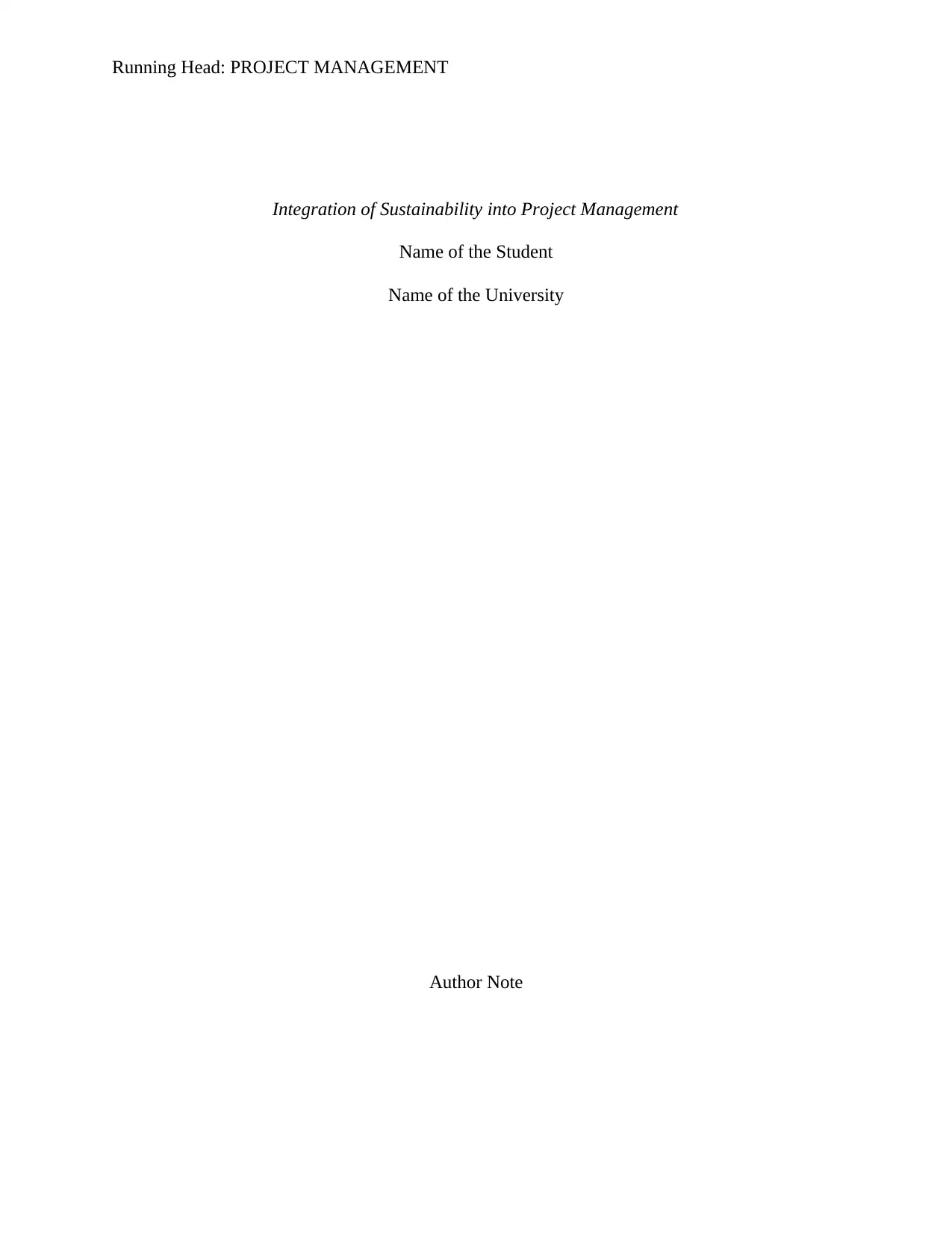
Running Head: PROJECT MANAGEMENT
Integration of Sustainability into Project Management
Name of the Student
Name of the University
Author Note
Integration of Sustainability into Project Management
Name of the Student
Name of the University
Author Note
Paraphrase This Document
Need a fresh take? Get an instant paraphrase of this document with our AI Paraphraser
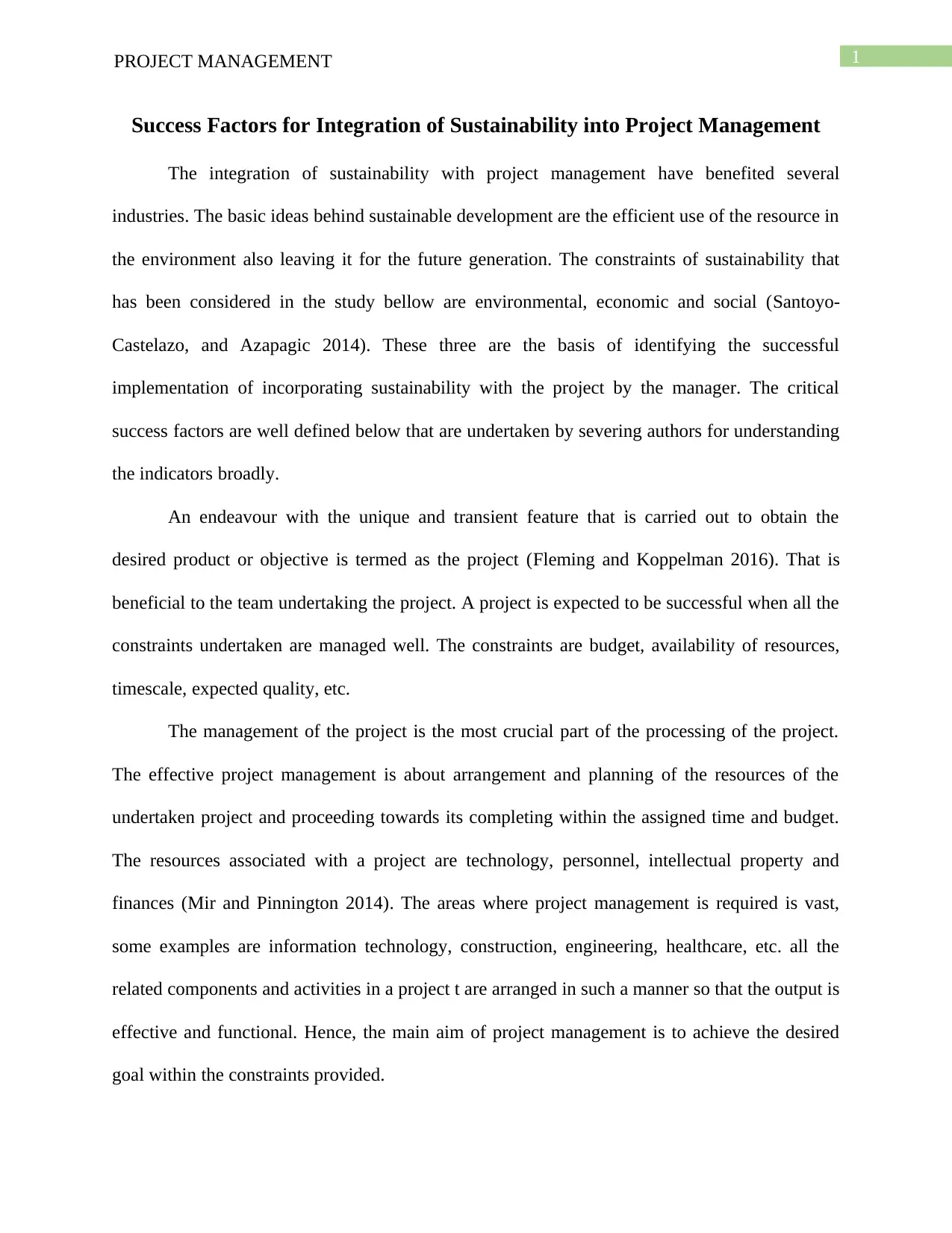
1PROJECT MANAGEMENT
Success Factors for Integration of Sustainability into Project Management
The integration of sustainability with project management have benefited several
industries. The basic ideas behind sustainable development are the efficient use of the resource in
the environment also leaving it for the future generation. The constraints of sustainability that
has been considered in the study bellow are environmental, economic and social (Santoyo-
Castelazo, and Azapagic 2014). These three are the basis of identifying the successful
implementation of incorporating sustainability with the project by the manager. The critical
success factors are well defined below that are undertaken by severing authors for understanding
the indicators broadly.
An endeavour with the unique and transient feature that is carried out to obtain the
desired product or objective is termed as the project (Fleming and Koppelman 2016). That is
beneficial to the team undertaking the project. A project is expected to be successful when all the
constraints undertaken are managed well. The constraints are budget, availability of resources,
timescale, expected quality, etc.
The management of the project is the most crucial part of the processing of the project.
The effective project management is about arrangement and planning of the resources of the
undertaken project and proceeding towards its completing within the assigned time and budget.
The resources associated with a project are technology, personnel, intellectual property and
finances (Mir and Pinnington 2014). The areas where project management is required is vast,
some examples are information technology, construction, engineering, healthcare, etc. all the
related components and activities in a project t are arranged in such a manner so that the output is
effective and functional. Hence, the main aim of project management is to achieve the desired
goal within the constraints provided.
Success Factors for Integration of Sustainability into Project Management
The integration of sustainability with project management have benefited several
industries. The basic ideas behind sustainable development are the efficient use of the resource in
the environment also leaving it for the future generation. The constraints of sustainability that
has been considered in the study bellow are environmental, economic and social (Santoyo-
Castelazo, and Azapagic 2014). These three are the basis of identifying the successful
implementation of incorporating sustainability with the project by the manager. The critical
success factors are well defined below that are undertaken by severing authors for understanding
the indicators broadly.
An endeavour with the unique and transient feature that is carried out to obtain the
desired product or objective is termed as the project (Fleming and Koppelman 2016). That is
beneficial to the team undertaking the project. A project is expected to be successful when all the
constraints undertaken are managed well. The constraints are budget, availability of resources,
timescale, expected quality, etc.
The management of the project is the most crucial part of the processing of the project.
The effective project management is about arrangement and planning of the resources of the
undertaken project and proceeding towards its completing within the assigned time and budget.
The resources associated with a project are technology, personnel, intellectual property and
finances (Mir and Pinnington 2014). The areas where project management is required is vast,
some examples are information technology, construction, engineering, healthcare, etc. all the
related components and activities in a project t are arranged in such a manner so that the output is
effective and functional. Hence, the main aim of project management is to achieve the desired
goal within the constraints provided.
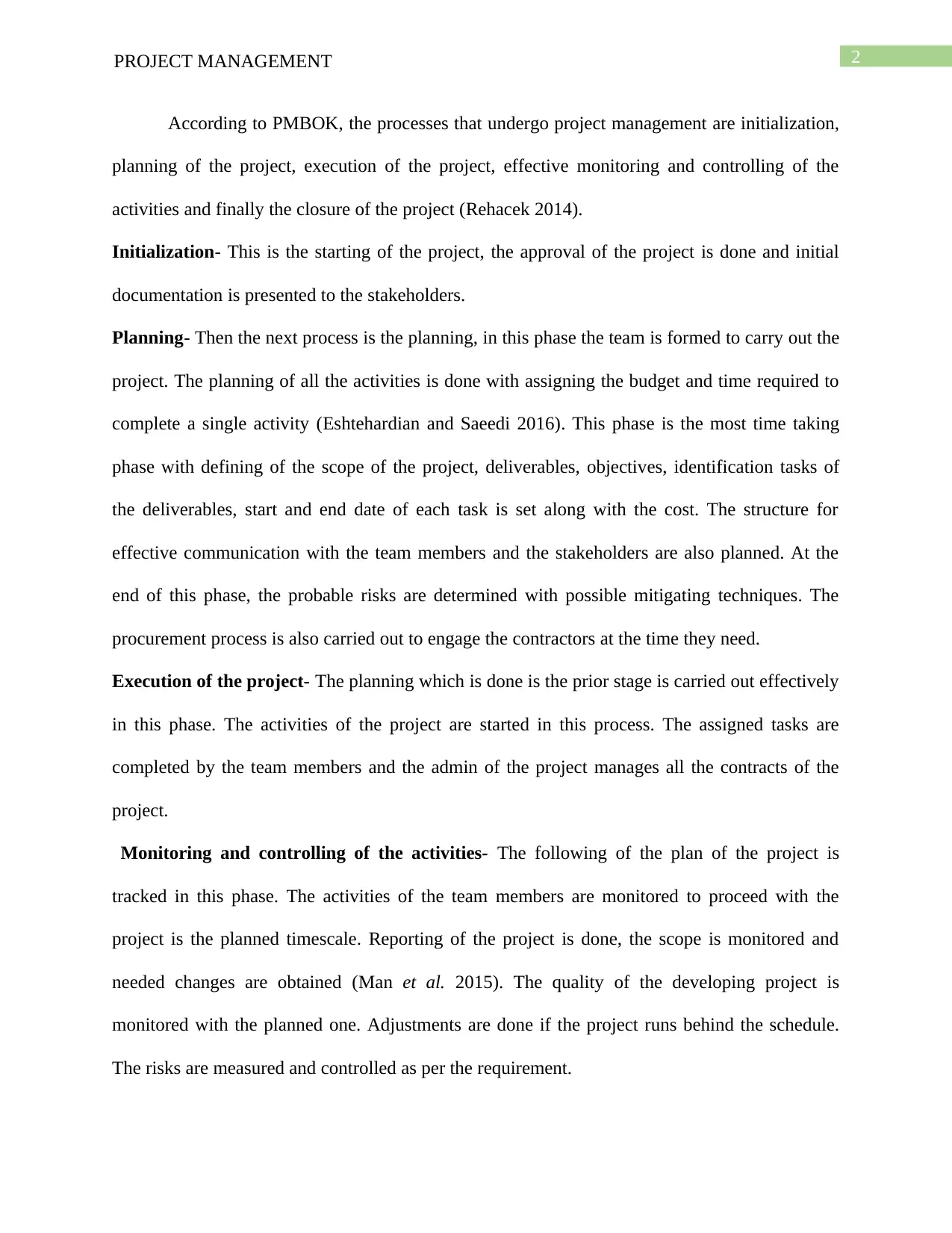
2PROJECT MANAGEMENT
According to PMBOK, the processes that undergo project management are initialization,
planning of the project, execution of the project, effective monitoring and controlling of the
activities and finally the closure of the project (Rehacek 2014).
Initialization- This is the starting of the project, the approval of the project is done and initial
documentation is presented to the stakeholders.
Planning- Then the next process is the planning, in this phase the team is formed to carry out the
project. The planning of all the activities is done with assigning the budget and time required to
complete a single activity (Eshtehardian and Saeedi 2016). This phase is the most time taking
phase with defining of the scope of the project, deliverables, objectives, identification tasks of
the deliverables, start and end date of each task is set along with the cost. The structure for
effective communication with the team members and the stakeholders are also planned. At the
end of this phase, the probable risks are determined with possible mitigating techniques. The
procurement process is also carried out to engage the contractors at the time they need.
Execution of the project- The planning which is done is the prior stage is carried out effectively
in this phase. The activities of the project are started in this process. The assigned tasks are
completed by the team members and the admin of the project manages all the contracts of the
project.
Monitoring and controlling of the activities- The following of the plan of the project is
tracked in this phase. The activities of the team members are monitored to proceed with the
project is the planned timescale. Reporting of the project is done, the scope is monitored and
needed changes are obtained (Man et al. 2015). The quality of the developing project is
monitored with the planned one. Adjustments are done if the project runs behind the schedule.
The risks are measured and controlled as per the requirement.
According to PMBOK, the processes that undergo project management are initialization,
planning of the project, execution of the project, effective monitoring and controlling of the
activities and finally the closure of the project (Rehacek 2014).
Initialization- This is the starting of the project, the approval of the project is done and initial
documentation is presented to the stakeholders.
Planning- Then the next process is the planning, in this phase the team is formed to carry out the
project. The planning of all the activities is done with assigning the budget and time required to
complete a single activity (Eshtehardian and Saeedi 2016). This phase is the most time taking
phase with defining of the scope of the project, deliverables, objectives, identification tasks of
the deliverables, start and end date of each task is set along with the cost. The structure for
effective communication with the team members and the stakeholders are also planned. At the
end of this phase, the probable risks are determined with possible mitigating techniques. The
procurement process is also carried out to engage the contractors at the time they need.
Execution of the project- The planning which is done is the prior stage is carried out effectively
in this phase. The activities of the project are started in this process. The assigned tasks are
completed by the team members and the admin of the project manages all the contracts of the
project.
Monitoring and controlling of the activities- The following of the plan of the project is
tracked in this phase. The activities of the team members are monitored to proceed with the
project is the planned timescale. Reporting of the project is done, the scope is monitored and
needed changes are obtained (Man et al. 2015). The quality of the developing project is
monitored with the planned one. Adjustments are done if the project runs behind the schedule.
The risks are measured and controlled as per the requirement.
⊘ This is a preview!⊘
Do you want full access?
Subscribe today to unlock all pages.

Trusted by 1+ million students worldwide
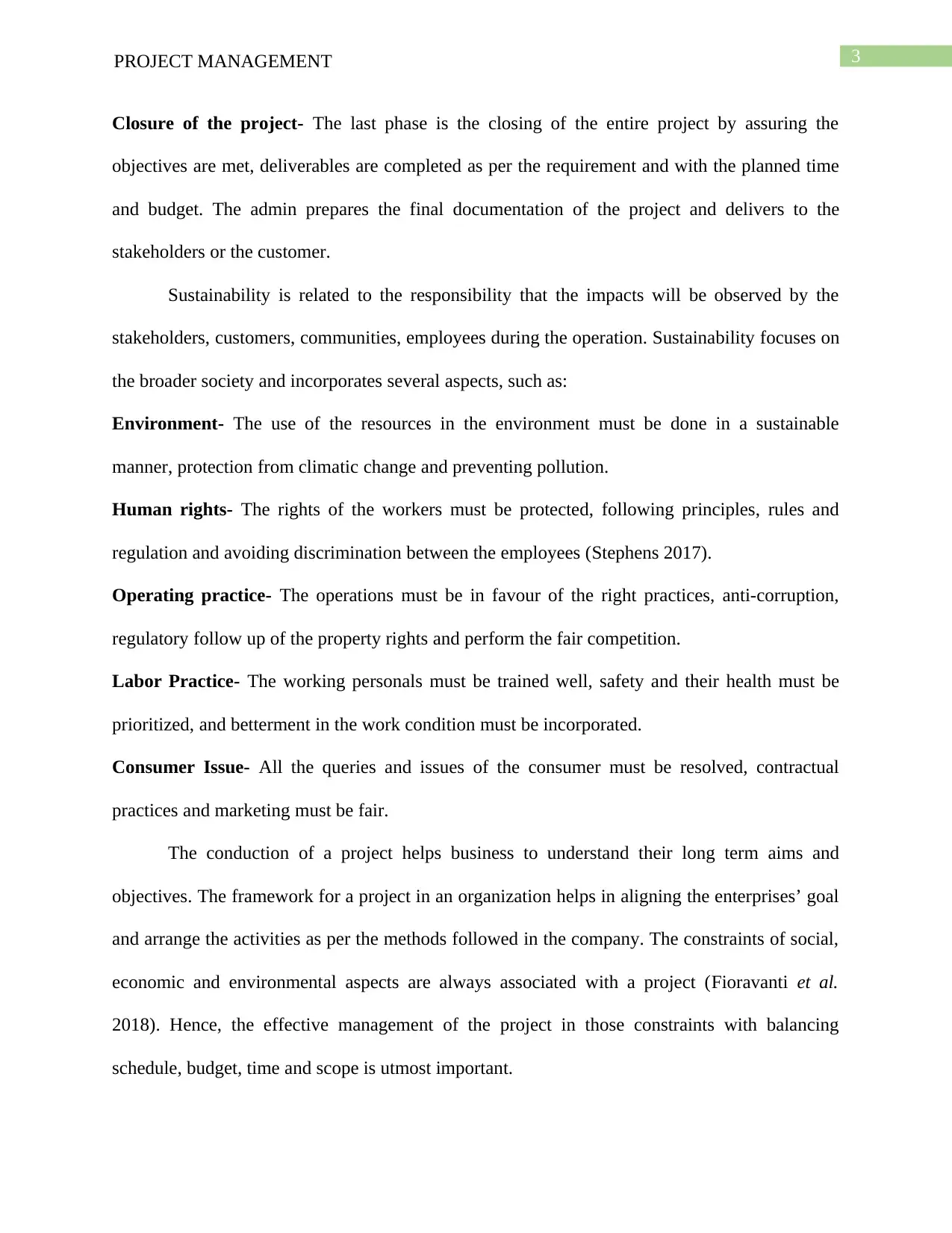
3PROJECT MANAGEMENT
Closure of the project- The last phase is the closing of the entire project by assuring the
objectives are met, deliverables are completed as per the requirement and with the planned time
and budget. The admin prepares the final documentation of the project and delivers to the
stakeholders or the customer.
Sustainability is related to the responsibility that the impacts will be observed by the
stakeholders, customers, communities, employees during the operation. Sustainability focuses on
the broader society and incorporates several aspects, such as:
Environment- The use of the resources in the environment must be done in a sustainable
manner, protection from climatic change and preventing pollution.
Human rights- The rights of the workers must be protected, following principles, rules and
regulation and avoiding discrimination between the employees (Stephens 2017).
Operating practice- The operations must be in favour of the right practices, anti-corruption,
regulatory follow up of the property rights and perform the fair competition.
Labor Practice- The working personals must be trained well, safety and their health must be
prioritized, and betterment in the work condition must be incorporated.
Consumer Issue- All the queries and issues of the consumer must be resolved, contractual
practices and marketing must be fair.
The conduction of a project helps business to understand their long term aims and
objectives. The framework for a project in an organization helps in aligning the enterprises’ goal
and arrange the activities as per the methods followed in the company. The constraints of social,
economic and environmental aspects are always associated with a project (Fioravanti et al.
2018). Hence, the effective management of the project in those constraints with balancing
schedule, budget, time and scope is utmost important.
Closure of the project- The last phase is the closing of the entire project by assuring the
objectives are met, deliverables are completed as per the requirement and with the planned time
and budget. The admin prepares the final documentation of the project and delivers to the
stakeholders or the customer.
Sustainability is related to the responsibility that the impacts will be observed by the
stakeholders, customers, communities, employees during the operation. Sustainability focuses on
the broader society and incorporates several aspects, such as:
Environment- The use of the resources in the environment must be done in a sustainable
manner, protection from climatic change and preventing pollution.
Human rights- The rights of the workers must be protected, following principles, rules and
regulation and avoiding discrimination between the employees (Stephens 2017).
Operating practice- The operations must be in favour of the right practices, anti-corruption,
regulatory follow up of the property rights and perform the fair competition.
Labor Practice- The working personals must be trained well, safety and their health must be
prioritized, and betterment in the work condition must be incorporated.
Consumer Issue- All the queries and issues of the consumer must be resolved, contractual
practices and marketing must be fair.
The conduction of a project helps business to understand their long term aims and
objectives. The framework for a project in an organization helps in aligning the enterprises’ goal
and arrange the activities as per the methods followed in the company. The constraints of social,
economic and environmental aspects are always associated with a project (Fioravanti et al.
2018). Hence, the effective management of the project in those constraints with balancing
schedule, budget, time and scope is utmost important.
Paraphrase This Document
Need a fresh take? Get an instant paraphrase of this document with our AI Paraphraser
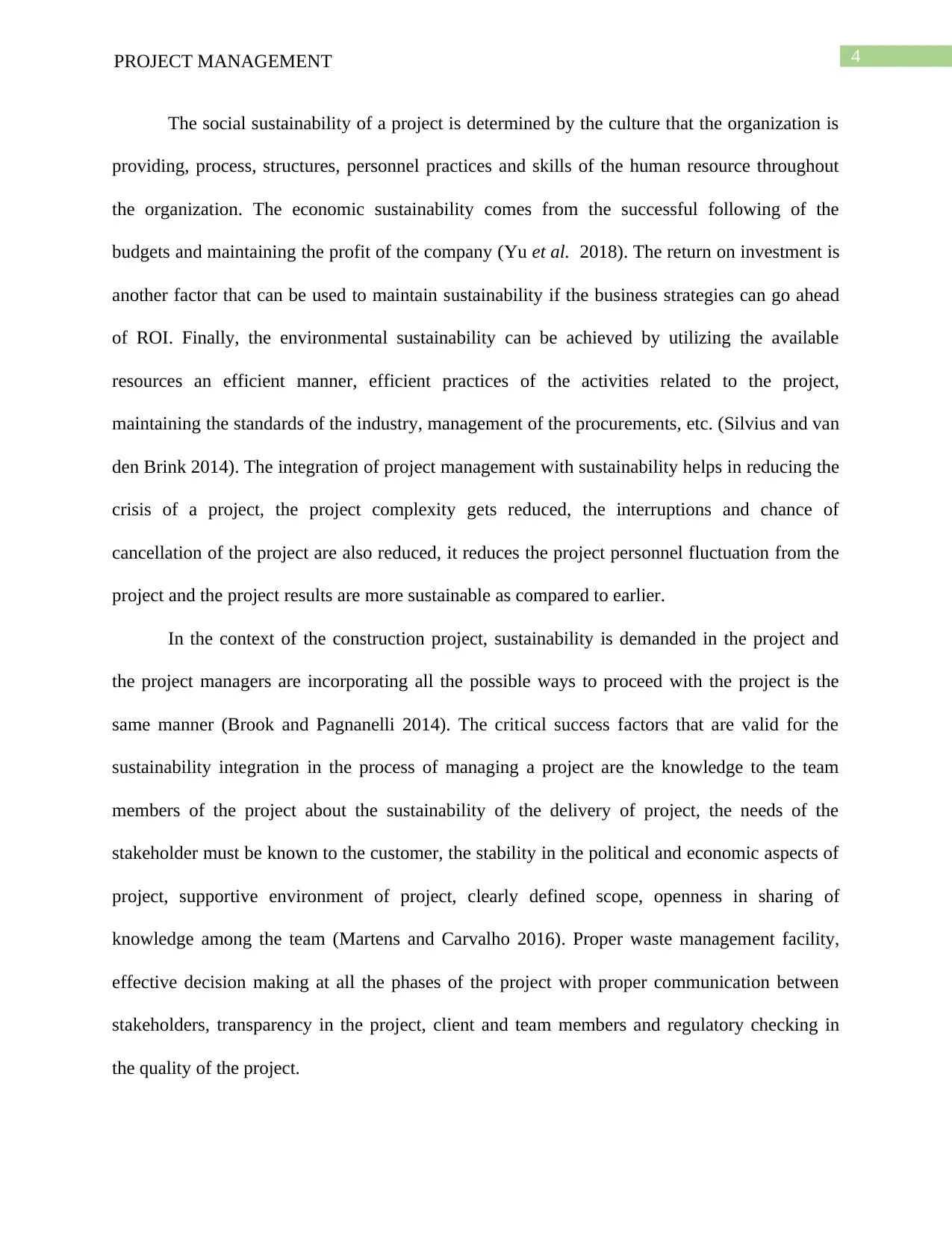
4PROJECT MANAGEMENT
The social sustainability of a project is determined by the culture that the organization is
providing, process, structures, personnel practices and skills of the human resource throughout
the organization. The economic sustainability comes from the successful following of the
budgets and maintaining the profit of the company (Yu et al. 2018). The return on investment is
another factor that can be used to maintain sustainability if the business strategies can go ahead
of ROI. Finally, the environmental sustainability can be achieved by utilizing the available
resources an efficient manner, efficient practices of the activities related to the project,
maintaining the standards of the industry, management of the procurements, etc. (Silvius and van
den Brink 2014). The integration of project management with sustainability helps in reducing the
crisis of a project, the project complexity gets reduced, the interruptions and chance of
cancellation of the project are also reduced, it reduces the project personnel fluctuation from the
project and the project results are more sustainable as compared to earlier.
In the context of the construction project, sustainability is demanded in the project and
the project managers are incorporating all the possible ways to proceed with the project is the
same manner (Brook and Pagnanelli 2014). The critical success factors that are valid for the
sustainability integration in the process of managing a project are the knowledge to the team
members of the project about the sustainability of the delivery of project, the needs of the
stakeholder must be known to the customer, the stability in the political and economic aspects of
project, supportive environment of project, clearly defined scope, openness in sharing of
knowledge among the team (Martens and Carvalho 2016). Proper waste management facility,
effective decision making at all the phases of the project with proper communication between
stakeholders, transparency in the project, client and team members and regulatory checking in
the quality of the project.
The social sustainability of a project is determined by the culture that the organization is
providing, process, structures, personnel practices and skills of the human resource throughout
the organization. The economic sustainability comes from the successful following of the
budgets and maintaining the profit of the company (Yu et al. 2018). The return on investment is
another factor that can be used to maintain sustainability if the business strategies can go ahead
of ROI. Finally, the environmental sustainability can be achieved by utilizing the available
resources an efficient manner, efficient practices of the activities related to the project,
maintaining the standards of the industry, management of the procurements, etc. (Silvius and van
den Brink 2014). The integration of project management with sustainability helps in reducing the
crisis of a project, the project complexity gets reduced, the interruptions and chance of
cancellation of the project are also reduced, it reduces the project personnel fluctuation from the
project and the project results are more sustainable as compared to earlier.
In the context of the construction project, sustainability is demanded in the project and
the project managers are incorporating all the possible ways to proceed with the project is the
same manner (Brook and Pagnanelli 2014). The critical success factors that are valid for the
sustainability integration in the process of managing a project are the knowledge to the team
members of the project about the sustainability of the delivery of project, the needs of the
stakeholder must be known to the customer, the stability in the political and economic aspects of
project, supportive environment of project, clearly defined scope, openness in sharing of
knowledge among the team (Martens and Carvalho 2016). Proper waste management facility,
effective decision making at all the phases of the project with proper communication between
stakeholders, transparency in the project, client and team members and regulatory checking in
the quality of the project.
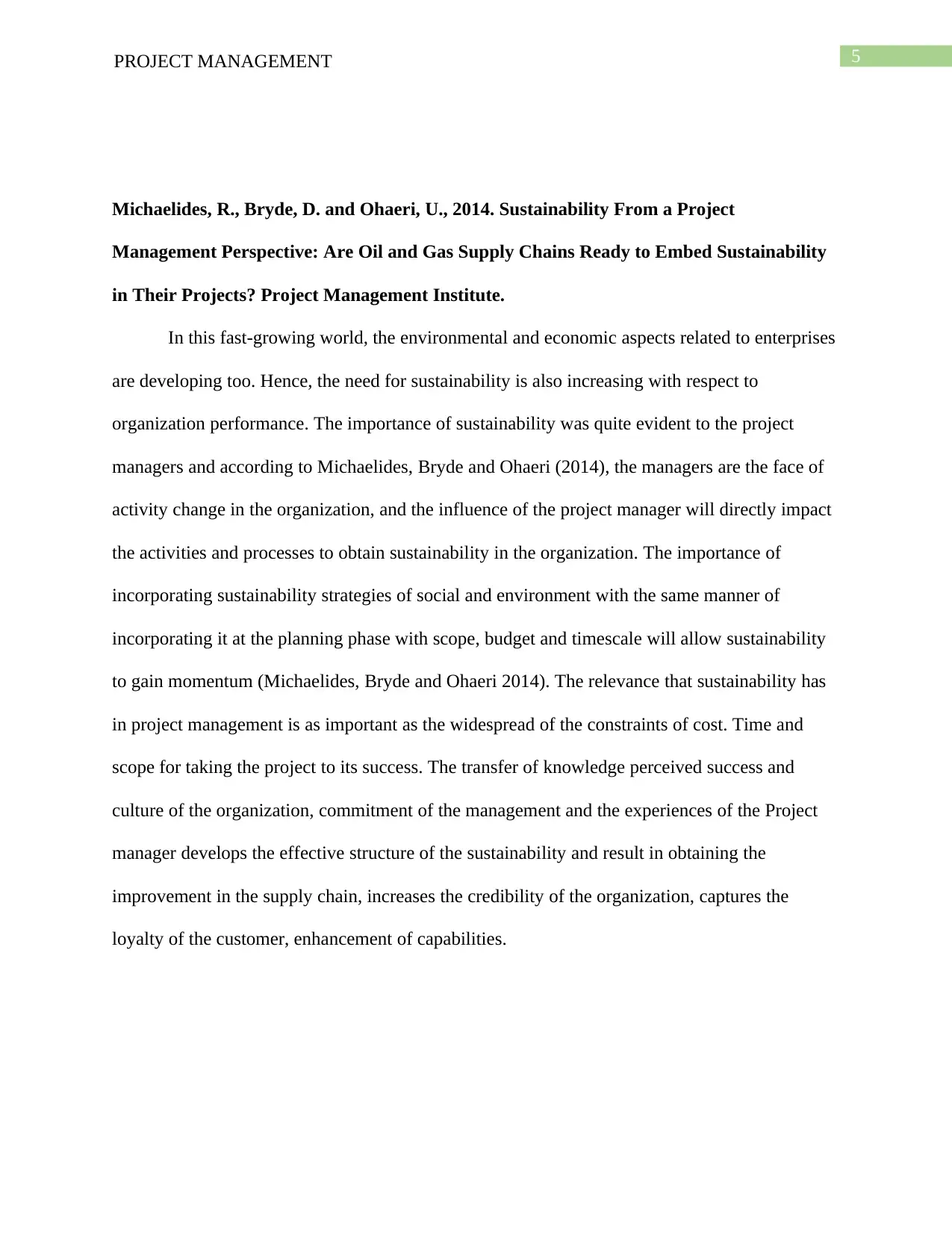
5PROJECT MANAGEMENT
Michaelides, R., Bryde, D. and Ohaeri, U., 2014. Sustainability From a Project
Management Perspective: Are Oil and Gas Supply Chains Ready to Embed Sustainability
in Their Projects? Project Management Institute.
In this fast-growing world, the environmental and economic aspects related to enterprises
are developing too. Hence, the need for sustainability is also increasing with respect to
organization performance. The importance of sustainability was quite evident to the project
managers and according to Michaelides, Bryde and Ohaeri (2014), the managers are the face of
activity change in the organization, and the influence of the project manager will directly impact
the activities and processes to obtain sustainability in the organization. The importance of
incorporating sustainability strategies of social and environment with the same manner of
incorporating it at the planning phase with scope, budget and timescale will allow sustainability
to gain momentum (Michaelides, Bryde and Ohaeri 2014). The relevance that sustainability has
in project management is as important as the widespread of the constraints of cost. Time and
scope for taking the project to its success. The transfer of knowledge perceived success and
culture of the organization, commitment of the management and the experiences of the Project
manager develops the effective structure of the sustainability and result in obtaining the
improvement in the supply chain, increases the credibility of the organization, captures the
loyalty of the customer, enhancement of capabilities.
Michaelides, R., Bryde, D. and Ohaeri, U., 2014. Sustainability From a Project
Management Perspective: Are Oil and Gas Supply Chains Ready to Embed Sustainability
in Their Projects? Project Management Institute.
In this fast-growing world, the environmental and economic aspects related to enterprises
are developing too. Hence, the need for sustainability is also increasing with respect to
organization performance. The importance of sustainability was quite evident to the project
managers and according to Michaelides, Bryde and Ohaeri (2014), the managers are the face of
activity change in the organization, and the influence of the project manager will directly impact
the activities and processes to obtain sustainability in the organization. The importance of
incorporating sustainability strategies of social and environment with the same manner of
incorporating it at the planning phase with scope, budget and timescale will allow sustainability
to gain momentum (Michaelides, Bryde and Ohaeri 2014). The relevance that sustainability has
in project management is as important as the widespread of the constraints of cost. Time and
scope for taking the project to its success. The transfer of knowledge perceived success and
culture of the organization, commitment of the management and the experiences of the Project
manager develops the effective structure of the sustainability and result in obtaining the
improvement in the supply chain, increases the credibility of the organization, captures the
loyalty of the customer, enhancement of capabilities.
⊘ This is a preview!⊘
Do you want full access?
Subscribe today to unlock all pages.

Trusted by 1+ million students worldwide
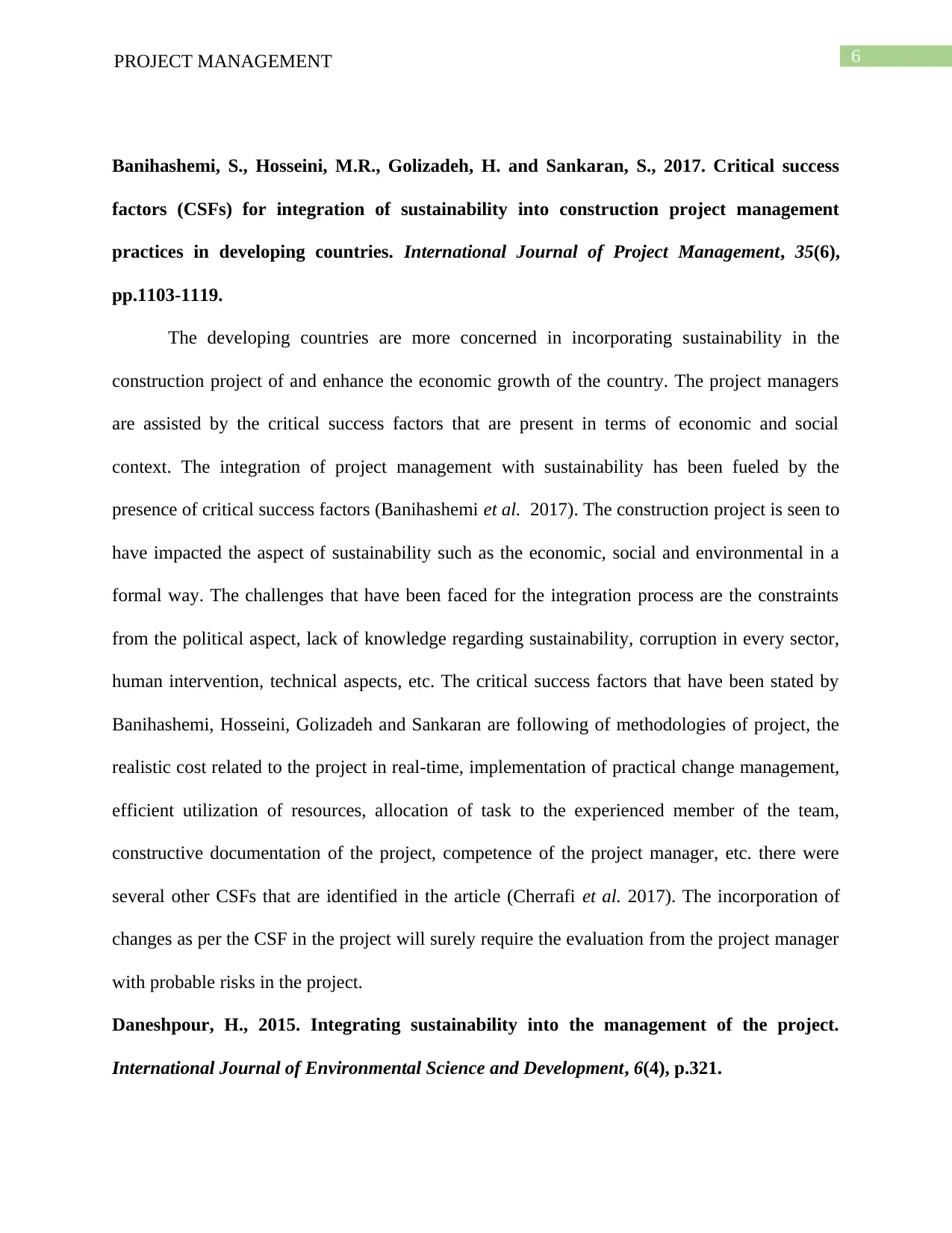
6PROJECT MANAGEMENT
Banihashemi, S., Hosseini, M.R., Golizadeh, H. and Sankaran, S., 2017. Critical success
factors (CSFs) for integration of sustainability into construction project management
practices in developing countries. International Journal of Project Management, 35(6),
pp.1103-1119.
The developing countries are more concerned in incorporating sustainability in the
construction project of and enhance the economic growth of the country. The project managers
are assisted by the critical success factors that are present in terms of economic and social
context. The integration of project management with sustainability has been fueled by the
presence of critical success factors (Banihashemi et al. 2017). The construction project is seen to
have impacted the aspect of sustainability such as the economic, social and environmental in a
formal way. The challenges that have been faced for the integration process are the constraints
from the political aspect, lack of knowledge regarding sustainability, corruption in every sector,
human intervention, technical aspects, etc. The critical success factors that have been stated by
Banihashemi, Hosseini, Golizadeh and Sankaran are following of methodologies of project, the
realistic cost related to the project in real-time, implementation of practical change management,
efficient utilization of resources, allocation of task to the experienced member of the team,
constructive documentation of the project, competence of the project manager, etc. there were
several other CSFs that are identified in the article (Cherrafi et al. 2017). The incorporation of
changes as per the CSF in the project will surely require the evaluation from the project manager
with probable risks in the project.
Daneshpour, H., 2015. Integrating sustainability into the management of the project.
International Journal of Environmental Science and Development, 6(4), p.321.
Banihashemi, S., Hosseini, M.R., Golizadeh, H. and Sankaran, S., 2017. Critical success
factors (CSFs) for integration of sustainability into construction project management
practices in developing countries. International Journal of Project Management, 35(6),
pp.1103-1119.
The developing countries are more concerned in incorporating sustainability in the
construction project of and enhance the economic growth of the country. The project managers
are assisted by the critical success factors that are present in terms of economic and social
context. The integration of project management with sustainability has been fueled by the
presence of critical success factors (Banihashemi et al. 2017). The construction project is seen to
have impacted the aspect of sustainability such as the economic, social and environmental in a
formal way. The challenges that have been faced for the integration process are the constraints
from the political aspect, lack of knowledge regarding sustainability, corruption in every sector,
human intervention, technical aspects, etc. The critical success factors that have been stated by
Banihashemi, Hosseini, Golizadeh and Sankaran are following of methodologies of project, the
realistic cost related to the project in real-time, implementation of practical change management,
efficient utilization of resources, allocation of task to the experienced member of the team,
constructive documentation of the project, competence of the project manager, etc. there were
several other CSFs that are identified in the article (Cherrafi et al. 2017). The incorporation of
changes as per the CSF in the project will surely require the evaluation from the project manager
with probable risks in the project.
Daneshpour, H., 2015. Integrating sustainability into the management of the project.
International Journal of Environmental Science and Development, 6(4), p.321.
Paraphrase This Document
Need a fresh take? Get an instant paraphrase of this document with our AI Paraphraser
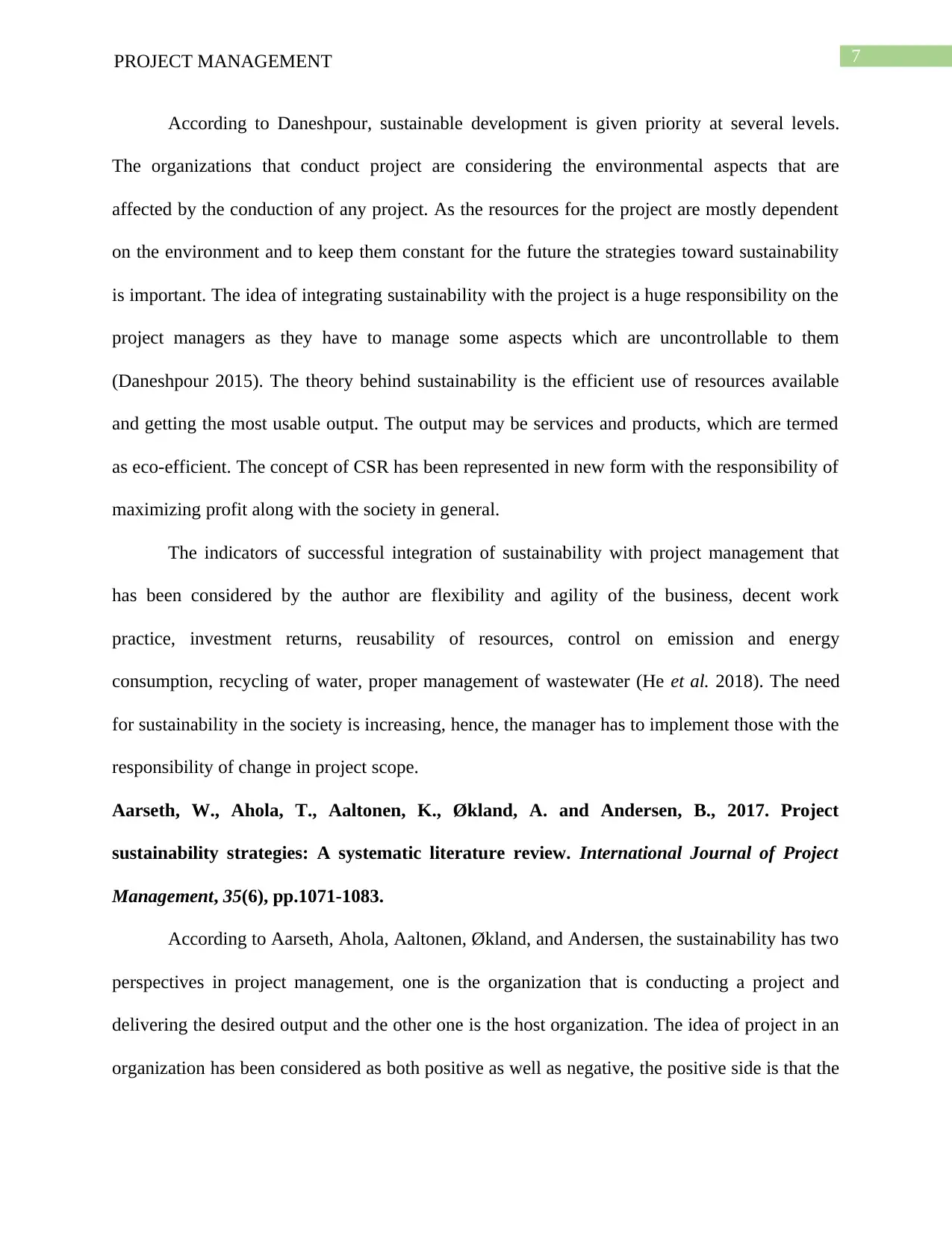
7PROJECT MANAGEMENT
According to Daneshpour, sustainable development is given priority at several levels.
The organizations that conduct project are considering the environmental aspects that are
affected by the conduction of any project. As the resources for the project are mostly dependent
on the environment and to keep them constant for the future the strategies toward sustainability
is important. The idea of integrating sustainability with the project is a huge responsibility on the
project managers as they have to manage some aspects which are uncontrollable to them
(Daneshpour 2015). The theory behind sustainability is the efficient use of resources available
and getting the most usable output. The output may be services and products, which are termed
as eco-efficient. The concept of CSR has been represented in new form with the responsibility of
maximizing profit along with the society in general.
The indicators of successful integration of sustainability with project management that
has been considered by the author are flexibility and agility of the business, decent work
practice, investment returns, reusability of resources, control on emission and energy
consumption, recycling of water, proper management of wastewater (He et al. 2018). The need
for sustainability in the society is increasing, hence, the manager has to implement those with the
responsibility of change in project scope.
Aarseth, W., Ahola, T., Aaltonen, K., Økland, A. and Andersen, B., 2017. Project
sustainability strategies: A systematic literature review. International Journal of Project
Management, 35(6), pp.1071-1083.
According to Aarseth, Ahola, Aaltonen, Økland, and Andersen, the sustainability has two
perspectives in project management, one is the organization that is conducting a project and
delivering the desired output and the other one is the host organization. The idea of project in an
organization has been considered as both positive as well as negative, the positive side is that the
According to Daneshpour, sustainable development is given priority at several levels.
The organizations that conduct project are considering the environmental aspects that are
affected by the conduction of any project. As the resources for the project are mostly dependent
on the environment and to keep them constant for the future the strategies toward sustainability
is important. The idea of integrating sustainability with the project is a huge responsibility on the
project managers as they have to manage some aspects which are uncontrollable to them
(Daneshpour 2015). The theory behind sustainability is the efficient use of resources available
and getting the most usable output. The output may be services and products, which are termed
as eco-efficient. The concept of CSR has been represented in new form with the responsibility of
maximizing profit along with the society in general.
The indicators of successful integration of sustainability with project management that
has been considered by the author are flexibility and agility of the business, decent work
practice, investment returns, reusability of resources, control on emission and energy
consumption, recycling of water, proper management of wastewater (He et al. 2018). The need
for sustainability in the society is increasing, hence, the manager has to implement those with the
responsibility of change in project scope.
Aarseth, W., Ahola, T., Aaltonen, K., Økland, A. and Andersen, B., 2017. Project
sustainability strategies: A systematic literature review. International Journal of Project
Management, 35(6), pp.1071-1083.
According to Aarseth, Ahola, Aaltonen, Økland, and Andersen, the sustainability has two
perspectives in project management, one is the organization that is conducting a project and
delivering the desired output and the other one is the host organization. The idea of project in an
organization has been considered as both positive as well as negative, the positive side is that the
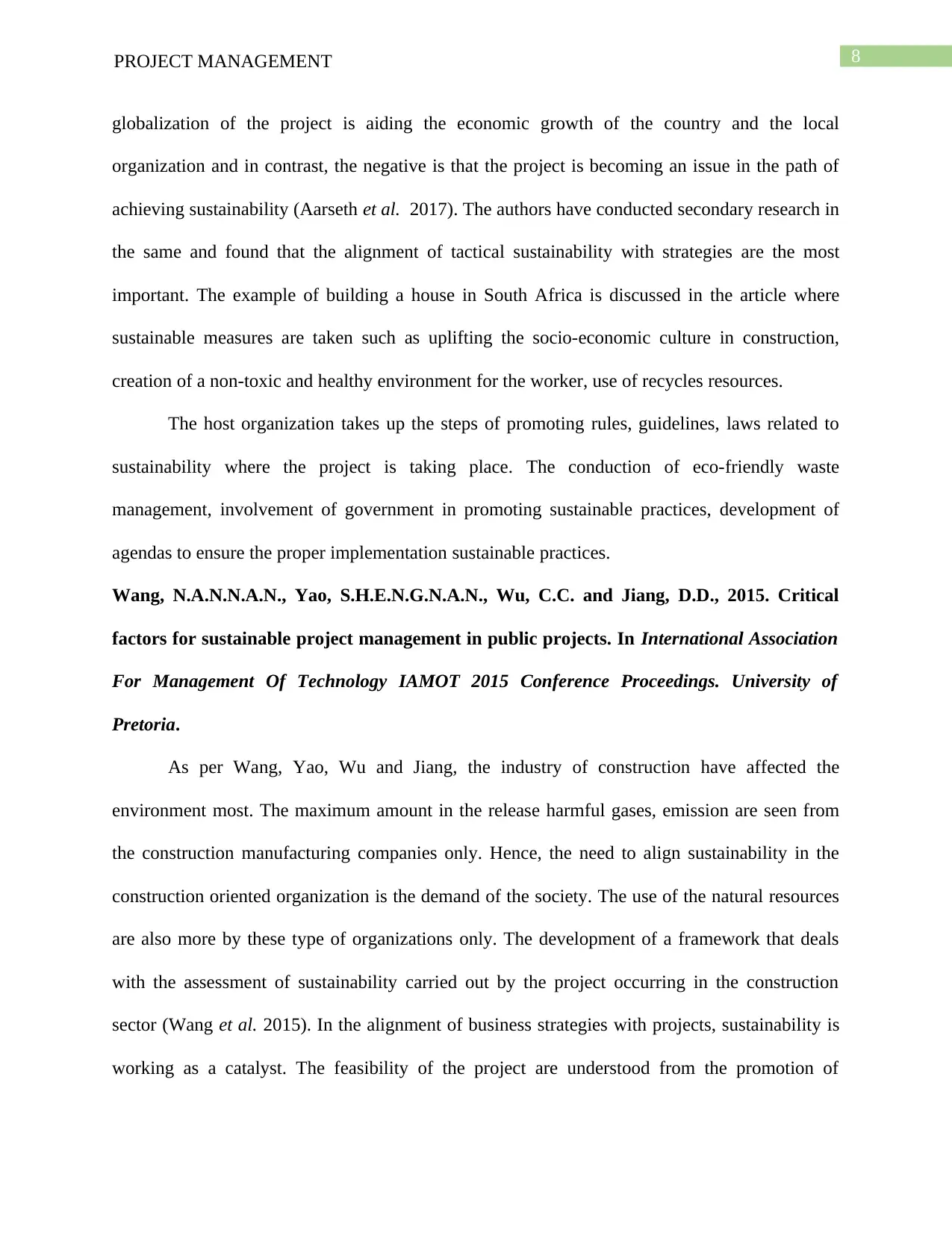
8PROJECT MANAGEMENT
globalization of the project is aiding the economic growth of the country and the local
organization and in contrast, the negative is that the project is becoming an issue in the path of
achieving sustainability (Aarseth et al. 2017). The authors have conducted secondary research in
the same and found that the alignment of tactical sustainability with strategies are the most
important. The example of building a house in South Africa is discussed in the article where
sustainable measures are taken such as uplifting the socio-economic culture in construction,
creation of a non-toxic and healthy environment for the worker, use of recycles resources.
The host organization takes up the steps of promoting rules, guidelines, laws related to
sustainability where the project is taking place. The conduction of eco-friendly waste
management, involvement of government in promoting sustainable practices, development of
agendas to ensure the proper implementation sustainable practices.
Wang, N.A.N.N.A.N., Yao, S.H.E.N.G.N.A.N., Wu, C.C. and Jiang, D.D., 2015. Critical
factors for sustainable project management in public projects. In International Association
For Management Of Technology IAMOT 2015 Conference Proceedings. University of
Pretoria.
As per Wang, Yao, Wu and Jiang, the industry of construction have affected the
environment most. The maximum amount in the release harmful gases, emission are seen from
the construction manufacturing companies only. Hence, the need to align sustainability in the
construction oriented organization is the demand of the society. The use of the natural resources
are also more by these type of organizations only. The development of a framework that deals
with the assessment of sustainability carried out by the project occurring in the construction
sector (Wang et al. 2015). In the alignment of business strategies with projects, sustainability is
working as a catalyst. The feasibility of the project are understood from the promotion of
globalization of the project is aiding the economic growth of the country and the local
organization and in contrast, the negative is that the project is becoming an issue in the path of
achieving sustainability (Aarseth et al. 2017). The authors have conducted secondary research in
the same and found that the alignment of tactical sustainability with strategies are the most
important. The example of building a house in South Africa is discussed in the article where
sustainable measures are taken such as uplifting the socio-economic culture in construction,
creation of a non-toxic and healthy environment for the worker, use of recycles resources.
The host organization takes up the steps of promoting rules, guidelines, laws related to
sustainability where the project is taking place. The conduction of eco-friendly waste
management, involvement of government in promoting sustainable practices, development of
agendas to ensure the proper implementation sustainable practices.
Wang, N.A.N.N.A.N., Yao, S.H.E.N.G.N.A.N., Wu, C.C. and Jiang, D.D., 2015. Critical
factors for sustainable project management in public projects. In International Association
For Management Of Technology IAMOT 2015 Conference Proceedings. University of
Pretoria.
As per Wang, Yao, Wu and Jiang, the industry of construction have affected the
environment most. The maximum amount in the release harmful gases, emission are seen from
the construction manufacturing companies only. Hence, the need to align sustainability in the
construction oriented organization is the demand of the society. The use of the natural resources
are also more by these type of organizations only. The development of a framework that deals
with the assessment of sustainability carried out by the project occurring in the construction
sector (Wang et al. 2015). In the alignment of business strategies with projects, sustainability is
working as a catalyst. The feasibility of the project are understood from the promotion of
⊘ This is a preview!⊘
Do you want full access?
Subscribe today to unlock all pages.

Trusted by 1+ million students worldwide
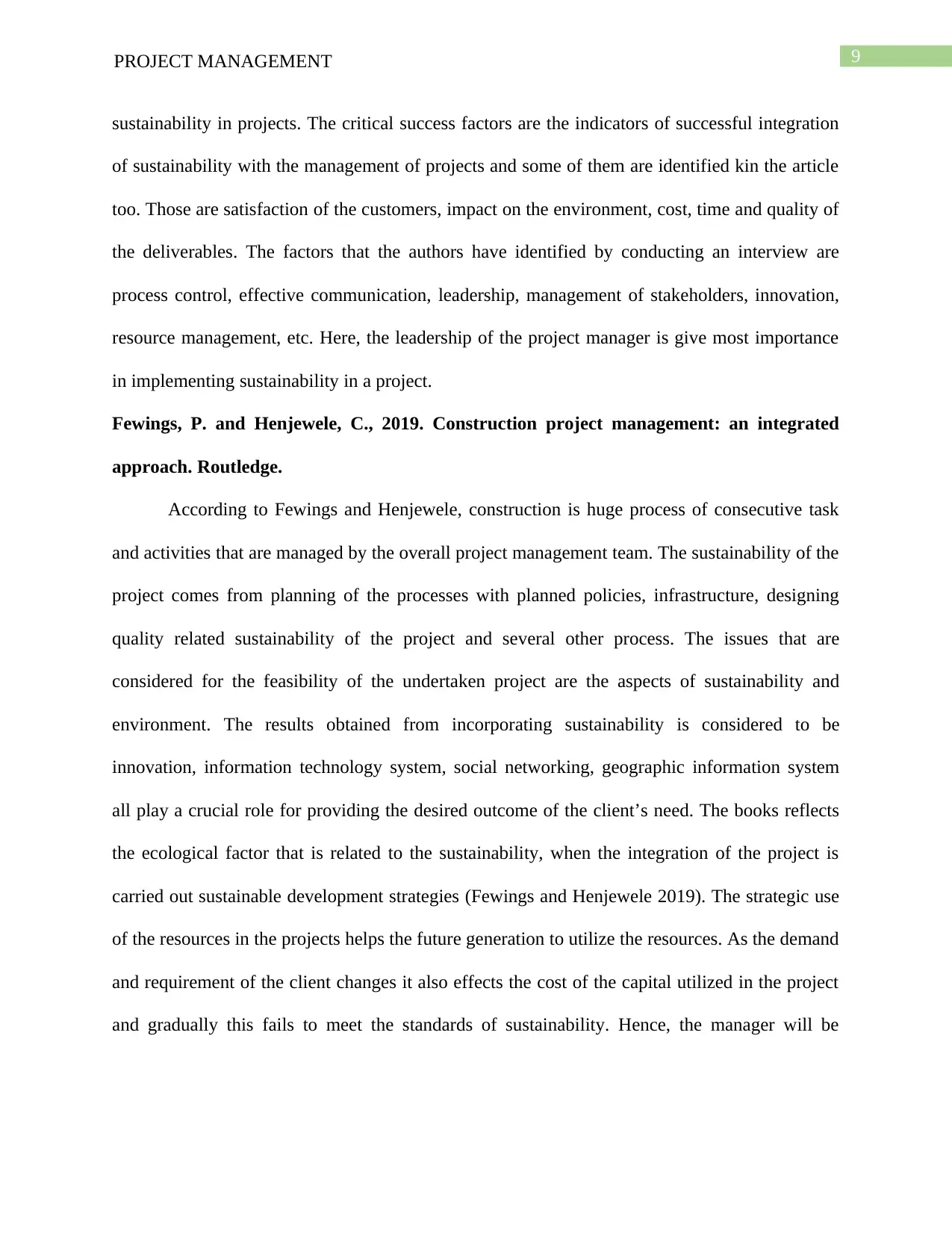
9PROJECT MANAGEMENT
sustainability in projects. The critical success factors are the indicators of successful integration
of sustainability with the management of projects and some of them are identified kin the article
too. Those are satisfaction of the customers, impact on the environment, cost, time and quality of
the deliverables. The factors that the authors have identified by conducting an interview are
process control, effective communication, leadership, management of stakeholders, innovation,
resource management, etc. Here, the leadership of the project manager is give most importance
in implementing sustainability in a project.
Fewings, P. and Henjewele, C., 2019. Construction project management: an integrated
approach. Routledge.
According to Fewings and Henjewele, construction is huge process of consecutive task
and activities that are managed by the overall project management team. The sustainability of the
project comes from planning of the processes with planned policies, infrastructure, designing
quality related sustainability of the project and several other process. The issues that are
considered for the feasibility of the undertaken project are the aspects of sustainability and
environment. The results obtained from incorporating sustainability is considered to be
innovation, information technology system, social networking, geographic information system
all play a crucial role for providing the desired outcome of the client’s need. The books reflects
the ecological factor that is related to the sustainability, when the integration of the project is
carried out sustainable development strategies (Fewings and Henjewele 2019). The strategic use
of the resources in the projects helps the future generation to utilize the resources. As the demand
and requirement of the client changes it also effects the cost of the capital utilized in the project
and gradually this fails to meet the standards of sustainability. Hence, the manager will be
sustainability in projects. The critical success factors are the indicators of successful integration
of sustainability with the management of projects and some of them are identified kin the article
too. Those are satisfaction of the customers, impact on the environment, cost, time and quality of
the deliverables. The factors that the authors have identified by conducting an interview are
process control, effective communication, leadership, management of stakeholders, innovation,
resource management, etc. Here, the leadership of the project manager is give most importance
in implementing sustainability in a project.
Fewings, P. and Henjewele, C., 2019. Construction project management: an integrated
approach. Routledge.
According to Fewings and Henjewele, construction is huge process of consecutive task
and activities that are managed by the overall project management team. The sustainability of the
project comes from planning of the processes with planned policies, infrastructure, designing
quality related sustainability of the project and several other process. The issues that are
considered for the feasibility of the undertaken project are the aspects of sustainability and
environment. The results obtained from incorporating sustainability is considered to be
innovation, information technology system, social networking, geographic information system
all play a crucial role for providing the desired outcome of the client’s need. The books reflects
the ecological factor that is related to the sustainability, when the integration of the project is
carried out sustainable development strategies (Fewings and Henjewele 2019). The strategic use
of the resources in the projects helps the future generation to utilize the resources. As the demand
and requirement of the client changes it also effects the cost of the capital utilized in the project
and gradually this fails to meet the standards of sustainability. Hence, the manager will be
Paraphrase This Document
Need a fresh take? Get an instant paraphrase of this document with our AI Paraphraser
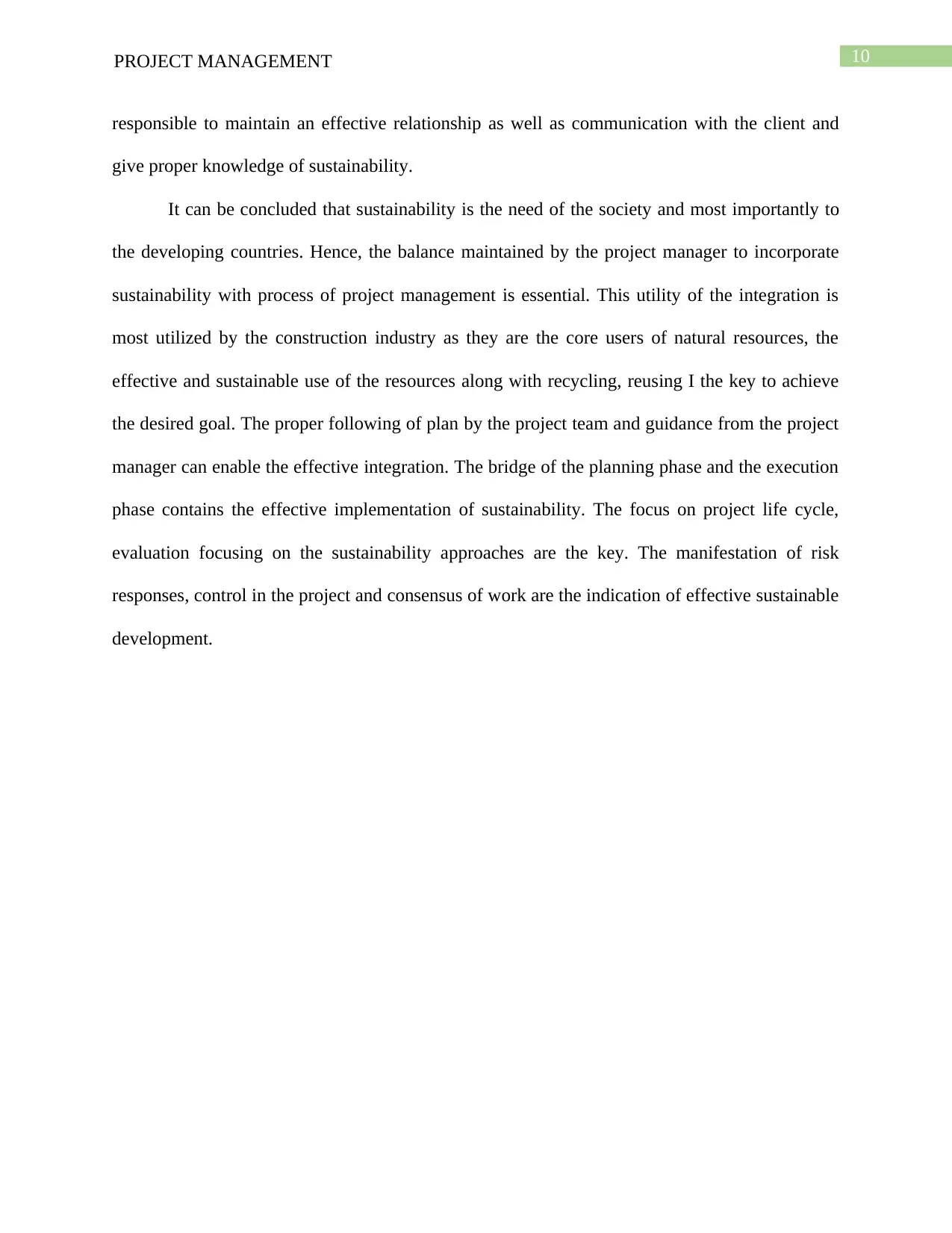
10PROJECT MANAGEMENT
responsible to maintain an effective relationship as well as communication with the client and
give proper knowledge of sustainability.
It can be concluded that sustainability is the need of the society and most importantly to
the developing countries. Hence, the balance maintained by the project manager to incorporate
sustainability with process of project management is essential. This utility of the integration is
most utilized by the construction industry as they are the core users of natural resources, the
effective and sustainable use of the resources along with recycling, reusing I the key to achieve
the desired goal. The proper following of plan by the project team and guidance from the project
manager can enable the effective integration. The bridge of the planning phase and the execution
phase contains the effective implementation of sustainability. The focus on project life cycle,
evaluation focusing on the sustainability approaches are the key. The manifestation of risk
responses, control in the project and consensus of work are the indication of effective sustainable
development.
responsible to maintain an effective relationship as well as communication with the client and
give proper knowledge of sustainability.
It can be concluded that sustainability is the need of the society and most importantly to
the developing countries. Hence, the balance maintained by the project manager to incorporate
sustainability with process of project management is essential. This utility of the integration is
most utilized by the construction industry as they are the core users of natural resources, the
effective and sustainable use of the resources along with recycling, reusing I the key to achieve
the desired goal. The proper following of plan by the project team and guidance from the project
manager can enable the effective integration. The bridge of the planning phase and the execution
phase contains the effective implementation of sustainability. The focus on project life cycle,
evaluation focusing on the sustainability approaches are the key. The manifestation of risk
responses, control in the project and consensus of work are the indication of effective sustainable
development.
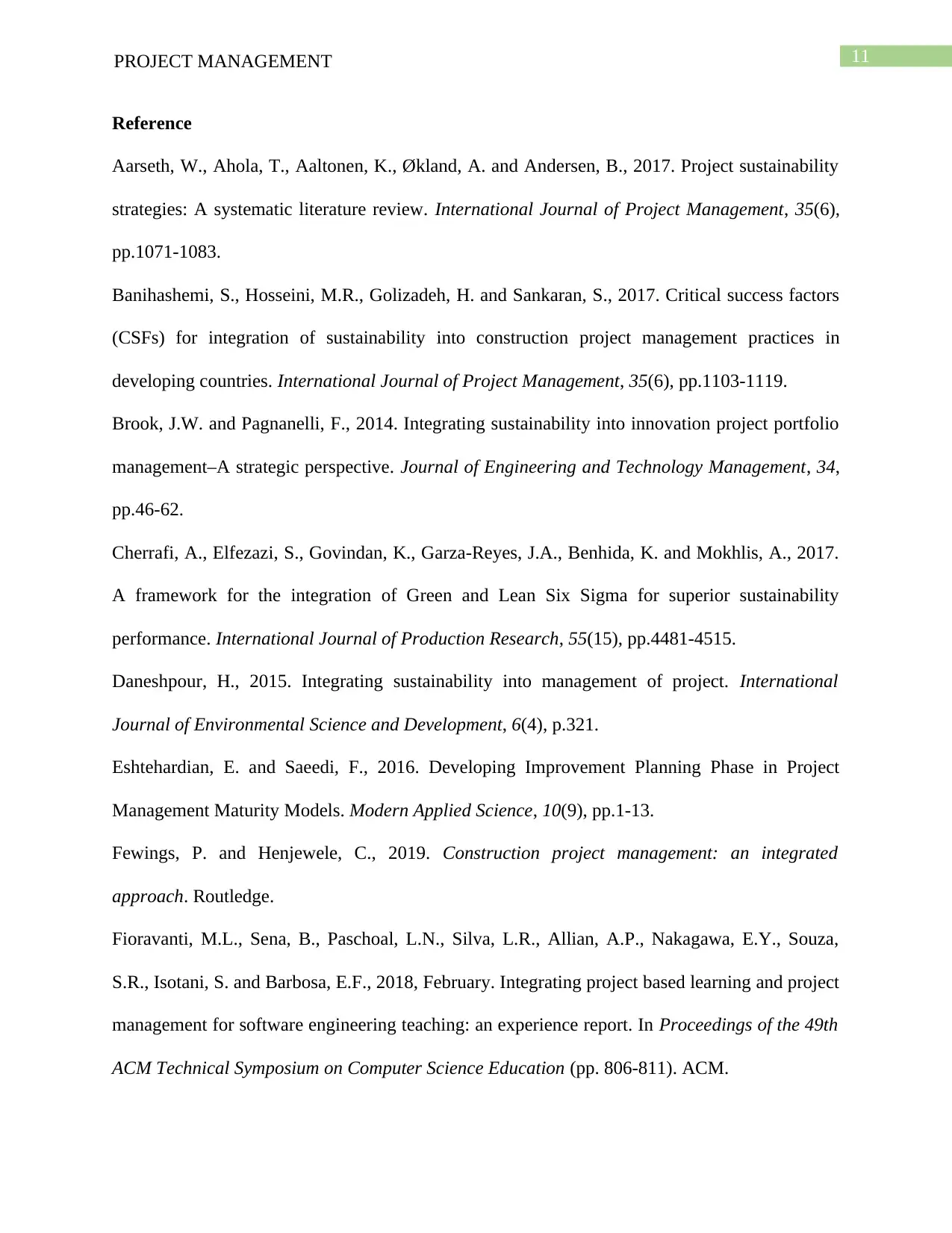
11PROJECT MANAGEMENT
Reference
Aarseth, W., Ahola, T., Aaltonen, K., Økland, A. and Andersen, B., 2017. Project sustainability
strategies: A systematic literature review. International Journal of Project Management, 35(6),
pp.1071-1083.
Banihashemi, S., Hosseini, M.R., Golizadeh, H. and Sankaran, S., 2017. Critical success factors
(CSFs) for integration of sustainability into construction project management practices in
developing countries. International Journal of Project Management, 35(6), pp.1103-1119.
Brook, J.W. and Pagnanelli, F., 2014. Integrating sustainability into innovation project portfolio
management–A strategic perspective. Journal of Engineering and Technology Management, 34,
pp.46-62.
Cherrafi, A., Elfezazi, S., Govindan, K., Garza-Reyes, J.A., Benhida, K. and Mokhlis, A., 2017.
A framework for the integration of Green and Lean Six Sigma for superior sustainability
performance. International Journal of Production Research, 55(15), pp.4481-4515.
Daneshpour, H., 2015. Integrating sustainability into management of project. International
Journal of Environmental Science and Development, 6(4), p.321.
Eshtehardian, E. and Saeedi, F., 2016. Developing Improvement Planning Phase in Project
Management Maturity Models. Modern Applied Science, 10(9), pp.1-13.
Fewings, P. and Henjewele, C., 2019. Construction project management: an integrated
approach. Routledge.
Fioravanti, M.L., Sena, B., Paschoal, L.N., Silva, L.R., Allian, A.P., Nakagawa, E.Y., Souza,
S.R., Isotani, S. and Barbosa, E.F., 2018, February. Integrating project based learning and project
management for software engineering teaching: an experience report. In Proceedings of the 49th
ACM Technical Symposium on Computer Science Education (pp. 806-811). ACM.
Reference
Aarseth, W., Ahola, T., Aaltonen, K., Økland, A. and Andersen, B., 2017. Project sustainability
strategies: A systematic literature review. International Journal of Project Management, 35(6),
pp.1071-1083.
Banihashemi, S., Hosseini, M.R., Golizadeh, H. and Sankaran, S., 2017. Critical success factors
(CSFs) for integration of sustainability into construction project management practices in
developing countries. International Journal of Project Management, 35(6), pp.1103-1119.
Brook, J.W. and Pagnanelli, F., 2014. Integrating sustainability into innovation project portfolio
management–A strategic perspective. Journal of Engineering and Technology Management, 34,
pp.46-62.
Cherrafi, A., Elfezazi, S., Govindan, K., Garza-Reyes, J.A., Benhida, K. and Mokhlis, A., 2017.
A framework for the integration of Green and Lean Six Sigma for superior sustainability
performance. International Journal of Production Research, 55(15), pp.4481-4515.
Daneshpour, H., 2015. Integrating sustainability into management of project. International
Journal of Environmental Science and Development, 6(4), p.321.
Eshtehardian, E. and Saeedi, F., 2016. Developing Improvement Planning Phase in Project
Management Maturity Models. Modern Applied Science, 10(9), pp.1-13.
Fewings, P. and Henjewele, C., 2019. Construction project management: an integrated
approach. Routledge.
Fioravanti, M.L., Sena, B., Paschoal, L.N., Silva, L.R., Allian, A.P., Nakagawa, E.Y., Souza,
S.R., Isotani, S. and Barbosa, E.F., 2018, February. Integrating project based learning and project
management for software engineering teaching: an experience report. In Proceedings of the 49th
ACM Technical Symposium on Computer Science Education (pp. 806-811). ACM.
⊘ This is a preview!⊘
Do you want full access?
Subscribe today to unlock all pages.

Trusted by 1+ million students worldwide
1 out of 14
Related Documents
Your All-in-One AI-Powered Toolkit for Academic Success.
+13062052269
info@desklib.com
Available 24*7 on WhatsApp / Email
![[object Object]](/_next/static/media/star-bottom.7253800d.svg)
Unlock your academic potential
Copyright © 2020–2025 A2Z Services. All Rights Reserved. Developed and managed by ZUCOL.




